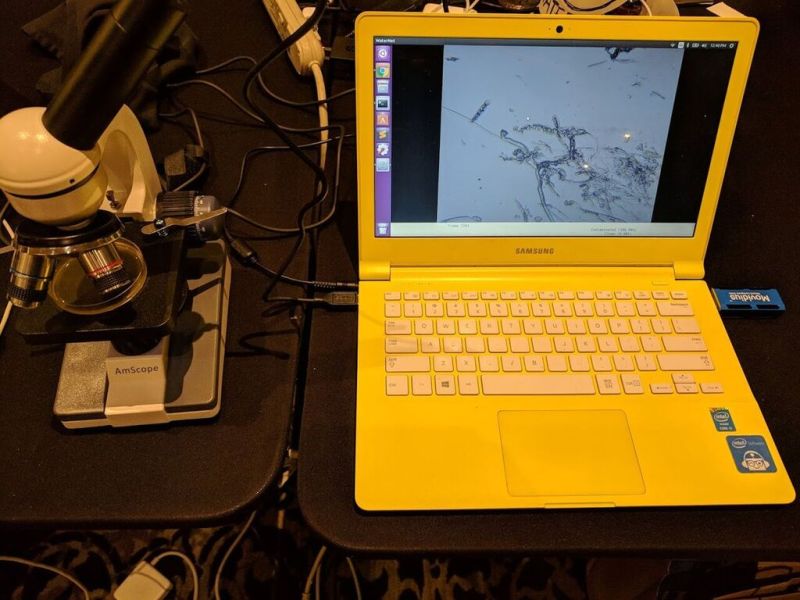It’s been a little over a year since Intel made the Movidius Neural Compute Stick (previously codenamed Fathom) generally available. The $79 thumb drive — a metal dongle housing a system-on-chip purpose-built for accelerating machine learning algorithms — was the product of chipmaker Movidius, which Intel acquired in September 2016. In the intervening months, it’s been used by thousands of developers and featured in “dozens” of research projects, according to Intel. And today marks the debut of its successor.
At Intel’s first AI developer conference in Beijing this week, the Santa Clara company took the wraps off of the Intel Neural Compute Stick 2, or NCS 2. It ditches its predecessor’s Myriad 2 Vision Processing Unit (VPU) — the chip inside Google’s Clip camera, Flir’s Firefly, DJI’s Phantom 4 drone, and Tencent’s DeepGaze camera — for the markedly more powerful Myriad X VPU, which Intel claims delivers 8 times the overall compute performance.
It’ll be available through JD.com in China; RS Components in Europe, the Middle East and Asia; Switch Sciences in Japan; and Mouser worldwide, starting today for $99.
Intel’s pitching NCS 2 as full stack solution for prototyping AI algorithms, like convolutional neural networks (CNNs), which form the backbone of many image recognition systems. Jonathan Ballon, vice president and general manager of Intel’s Internet of Things Group, told VentureBeat in a phone interview that it’s practically tailor-made for testing smart cameras, drones, industrial robots, and smart home devices.
June 5th: The AI Audit in NYC
Join us next week in NYC to engage with top executive leaders, delving into strategies for auditing AI models to ensure fairness, optimal performance, and ethical compliance across diverse organizations. Secure your attendance for this exclusive invite-only event.
“For the past four years or so, so much of AI has been happening in the cloud or datacenter, which is fine when you’ve got large volumes of data and you have unlimited compute resources, and power and cooling,” Ballon said. “[But] outside of the datacenter, power consumption is hugely important, as is heat and cost.” He added that leveraging the NCS 2 allows customers to work within those constraints “very easily.”
Myriad X inside
The NCS 2 supports USB 3.0/3.1, an improvement over the original NCS’s USB 2.0. It scales linearly, with additional NCS 2s.
Under the hood, the aforementioned Myriad X VPU — which is built on a 16nm FinFET process, as opposed to the Myriad 2’s 28nm node — has 16 128-bit streaming hybrid architecture vector engine (SHAVE) processor cores (up from the Myriad 2’s 12), as well as expanded 2.5MB on-chip memory and two general-purpose RISC cores. It packs new low-power vision accelerators, including a stereo block that can process dual 720p feeds at up to 180Hz, and a tunable integrated signal processor pipeline with hardware-based encode for up to 4K video resolution across 8 sensors (compared to Myriad 2’s 6).

Notably, Myriad X is the first VPU to feature Intel’s Neural Compute Engine, a dedicated hardware accelerator with native FP16 support and fixed-point 8-bit support.
Intel claims the chipset can hit 4 teraflops of compute and 1 trillion operations per second of dedicated neural net compute at full blast, or about 10 times the performance of the Myriad 2 in deep neural network inferencing. (Myriad 2 topped out at 1 to 1.5 trillion operations per second.)
“It’s really geared toward either a data scientist or an application developer that wants to get the maximum performance from various heterogeneous architectures based on whatever their power constraints are,” Ballon said.
Commercializing AI
Developers used the Movidius Compute Stick to build devices ranging from shark-spotting drones to low-cost skin cancer screening cameras, and Intel’s hoping for the same uptake this time around.
In addition to Intel’s Computer Vision SDK and Movidius Compute SDK, the NCS 2 supports OpenVINO (Open Visual Inference and Neural Network Optimization), a toolkit for AI edge computing that’s compatible with frameworks like Facebook’s Caffe2 and Google’s TensorFlow and comes with pretrained AI models for object detection, facial recognition, and object tracking.
Intel’s putting marketing muscle behind its Intel AI: In Production initiative, which launched last year, with the launch of the NCS 2. It’s essentially an end-to-end platform for bringing AI prototypes to market, Ballon explained.
“We want to go beyond academic trials and proof of concepts and [help commercialize] the innovations that the developer ecosystem is building,” he said.

Above: Clean Water AI, a product commercialized with the Neural Compute Stick.
To that end, developers who take advantage get access to Intel AI DevCloud clusters with storage and Intel Xeon Scalable processors in customizable configurations. Once they’ve tested, optimized, and validated their models remotely, they’re provided toolkits and code samples that make it easier to develop against hardware such as the NCS 2 or mini-PCIe development boards from manufacturers like Aaeon Technologies.
“This is a single pane of glass into our hardware that brings together software tools, training, experts, and ecosystems and helps developers find the right partners — whether they be ISP or cloud service providers, or even equipment builders,” Ballon said.
One developer in the Intel AI: In Production team — Peter Ma — pioneered a microbe detector for water supplies. His Clean Water AI system identifies bacteria in water supplies with a digital microscope and a pattern recognition algorithm running on Intel’s Myriad 2. It won first prize in the Dubai-based GovTechPrize’s World Virtual GovHack in 2017.
“The first-generation [NCS] sparked an entire community of AI developers into action with a form factor and price that didn’t exist before,” said Naveen Rao, Intel corporate vice president and general manager of the AI Products Group. “We’re excited to see what the community creates next with the strong enhancement to compute power enabled with the new Intel [NCS 2.”


